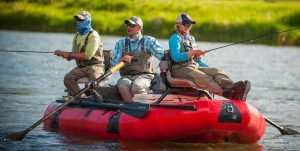Fly fishing from a raft offers a unique and exciting way to access remote fishing spots and cover more water than wading or bank fishing. Here’s a comprehensive guide on how to effectively fly fish from a raft.
1. Preparation
- Raft Selection: Choose a raft that is stable, spacious, and equipped for fishing. Look for features like rod holders, anchor systems, and comfortable seating.
- Gear Organization: Keep your gear organized and within easy reach. Use storage compartments or gear bags to prevent clutter and ensure you can quickly access your rods, flies, and other equipment.
2. Safety
- Life Jackets: Always wear a life jacket when on the water. Safety should be your top priority, regardless of your swimming ability.
- First Aid Kit: Carry a first aid kit with essentials for treating minor injuries or handling emergencies.
- Weather Awareness: Check weather forecasts and be prepared for sudden changes. Avoid fishing in extreme weather conditions.
3. Casting Techniques
- Short, Accurate Casts: From a moving raft, short and accurate casts are more effective than long ones. Practice your casting to ensure precision in targeting specific spots.
- Roll Casts: Roll casts are useful in tight quarters or when you need to quickly reposition your line. This technique is especially helpful when there’s limited space for a backcast.
- Double Haul: The double haul technique can help you cast further and more accurately. It involves pulling the line with your non-casting hand to load the rod for a powerful forward cast.

4. Raft Positioning
- Anchor Use: Use an anchor to hold the raft in position when you find a promising fishing spot. This allows you to fish thoroughly without drifting away.
- Drifting: When drifting, use oars to control the speed and direction of the raft. Slow, controlled drifts help present flies naturally to fish.
- Spotting Fish: Keep a keen eye on the water for signs of fish. Look for rising fish, surface disturbances, or underwater shadows to identify potential targets.
5. Fly Selection
- Match the Hatch: Pay attention to the local insect activity and choose flies that match the size, color, and behavior of the insects on the water.
- Streamers and Nymphs: Streamers and nymphs are effective in deeper water or fast currents. They imitate larger prey and can attract aggressive strikes from predatory fish.
- Dry Flies: Use dry flies to target fish feeding on the surface. Present them delicately to avoid spooking fish, especially in clear water.
6. Fish Handling
- Quick Release: Minimize handling time to reduce stress on the fish. Use a landing net to secure the fish and keep it in the water while removing the hook.
- Barbless Hooks: Consider using barbless hooks for easier hook removal and less damage to the fish.
- Photography: If you want to take a photo, have your camera ready and keep the fish in the water until you’re set. Lift it out briefly, take the photo, and release it promptly.
Fly fishing from a raft can be an exhilarating experience, offering access to untouched waters and abundant fishing opportunities. By preparing adequately, prioritizing safety, mastering casting techniques, and respecting the environment, you can enjoy a successful and memorable fishing trip.
Image: Orvis





